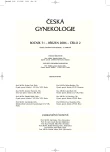Prenatal Detection of Congenital Mezoblastic Nephroma
Authors:
I. Musilová 1; P. Eliáš 2; J. Žižka 2; K. Hodík 1; E. Šimáková 3; V. Jüttnerová 4
Authors‘ workplace:
Porodnická a gynekologická klinika FN a LF UK, Hradec Králové, přednosta doc. MUDr. J. Tošner, CSc.
1; Klinika radiologická FN a LF UK, Hradec Králové, přednosta prof. MUDr. P. Eliáš, CSc.
2; Fingerlandův ústav patologie FN a LF UK, Hradec Králové, přednosta prof. MUDr. I. Šteiner, CSc.
3; Oddělení klinické genetiky, vedoucí MUDr. V. Jüttnerová
4
Published in:
Ceska Gynekol 2006; 71(2): 118-121
Category:
Original Article
Overview
Type of study:
Case report.
Setting:
Department of Gynecology and Obstetrics, Department of Radiology, Department of Pathology, Department of Medical Genetics, Charles University Hospital, Hradec Králové.
Methods:
The autors report a case of renal tumor in a fetus at 33 weeks of gestation detected by means of ultrasonography and magnetic resonance imaging. The pregnancy course was complicated by polyhydramnios. The female infant was born vaginally at 37 weeks of gestation. Postnatal nephrectomy confirmed prenatal diagnostic presumption – congenital mezoblastic nephroma. At folllow-up at 12 months of age, the infant had no evidence of the disease.
Conclusion.
Detection of renal tumor in a fetus is rare. Congenital mezoblastic nephroma with the favourable prognosis is most probable diagnosis. Prenatal detection enables the prevention of complications (prematurity prevention, detection of the developing cardial decompensation and fetal hydrops) with the planning of labour and postnatal management.
Key words:
mezoblastic nephroma, ultrasonography, magnetic resonance imaging, ring sign
Labels
Paediatric gynaecology Gynaecology and obstetrics Reproduction medicineArticle was published in
Czech Gynaecology

2006 Issue 2
Most read in this issue
- Embryo Quality Evaluation According to the Speed of the first Cleavage after Conventional IVF
- Serum Amyloid A as an Effective Marker for the Assessment of Surgical Trauma and Risk of Post-operative Complications
- Radical Parametrectomy in Women with Invasive Cervix Cancer after Previous Simple Hysterectomy
- Ursodeoxycholic Acid, S-adenosyl-L-methionine and their Combinations in the Treatment of Gestational Intrahepatic Cholestasis (ICP)
